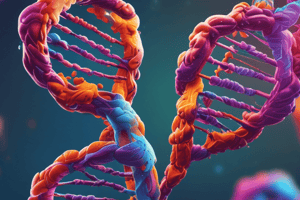Podcast
Questions and Answers
Which type of mutation creates stop codons, affecting protein function?
Which type of mutation creates stop codons, affecting protein function?
- Nonsense mutations (correct)
- Transversion mutations
- Transition mutations
- Deletion mutations
In the context of genetic mutations, what do interstitial deletions, micro deletions, and frame shift mutations have in common?
In the context of genetic mutations, what do interstitial deletions, micro deletions, and frame shift mutations have in common?
- They all involve the loss of genetic material (correct)
- They are all examples of conservative missense mutations
- They are all types of beneficial mutations
- They are related to somatic mutations
Which type of mutation replaces a purine base with a pyrimidine base or vice versa?
Which type of mutation replaces a purine base with a pyrimidine base or vice versa?
- Transition mutations
- Transversion mutations (correct)
- Frame shift mutations
- Missense mutations
How do germline mutations differ from somatic mutations?
How do germline mutations differ from somatic mutations?
Which type of mutation does not affect protein synthesis?
Which type of mutation does not affect protein synthesis?
What is the primary consequence of a deletion non-frame shift mutation?
What is the primary consequence of a deletion non-frame shift mutation?
Which of the following genetic disorders is associated with an insertion mutation?
Which of the following genetic disorders is associated with an insertion mutation?
What is the primary characteristic of a duplication mutation?
What is the primary characteristic of a duplication mutation?
Which type of mutation involves the exchange of DNA between chromosomes?
Which type of mutation involves the exchange of DNA between chromosomes?
Which of the following statements about inversion mutations is correct?
Which of the following statements about inversion mutations is correct?
Flashcards are hidden until you start studying
Study Notes
- Mutation is a permanent change in DNA or gene sequence, also present in RNA and proteins.
- Main causes of mutations include radiation, chemicals, and infectious agents.
- DNA mutations can be coding gene mutations or non-coding gene mutations.
- Types of mutations include DNA level, protein level (point mutations), molecular genetics, and chromosome mutations.
- Mutations can be beneficial, harmful, or neutral in nature.
- Germline mutations pass on to the next generation, somatic mutations do not.
- Example of retinoblastoma illustrates germline and somatic mutations.
- Neutral mutations do not affect protein synthesis.
- Transition mutations replace purine with purine or pyrimidine with pyrimidine, transversion mutations replace purine with pyrimidine or vice versa.
- Missense mutations change amino acids in proteins, can be conservative or non-conservative.
- Example of sickle cell anemia shows non-conservative missense mutation.
- Nonsense mutations create stop codons, affecting protein function.
- Deletion mutations fall under DNA level, protein level (frame shift deletion), molecular genetics, and chromosome mutations.
- Deletion mutations can be terminal, intercalary, or interstitial.- Gene 4 and Gene 3 are lost and degraded, leaving the repair system to join Gene 2, Gene 1, Gene 1, Gene 2, and Gene 3.
- Three types of deletions are discussed: interstitial deletions, micro deletions, and frame shift mutations.
- Micro deletions involve the deletion of one or two nucleotides, affecting the amino acid sequence and protein generated.
- Deletion non-frame shift mutation results in the loss of one amino acid.
- Deletion frame shift mutation causes a shift in amino acid sequence, altering the protein structure.
- Examples like cystic fibrosis illustrate deletion mutations and their impact on amino acids.
- Insertion mutations involve the addition of nucleotides, leading to changes in the polypeptide chain.
- Examples like Huntington disease showcase insertion mutations and their effects on proteins.
- Duplication mutations involve repeating a gene within a chromosome, leading to genetic disorders like Pallister-Killian syndrome.
- Inversion mutations involve flipping a portion of DNA, potentially impacting gene regulation and protein production.
- Translocation mutations involve the exchange of DNA between chromosomes, with examples like Down syndrome given to illustrate its impact.
Studying That Suits You
Use AI to generate personalized quizzes and flashcards to suit your learning preferences.




